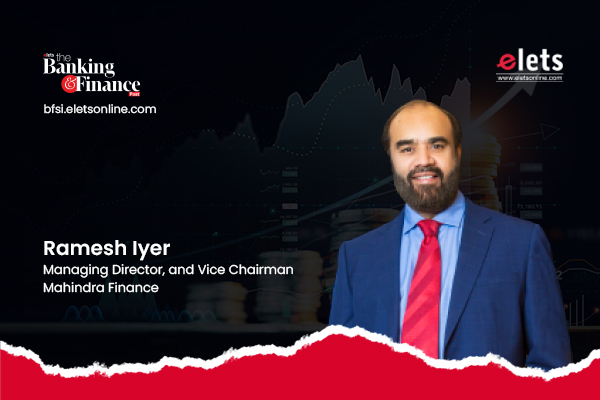The first and foremost principle is that, talent is never constant. It is crucial to invest in your people to ensure that they remain relevant for the present and future. Every employee should be employable at any point in time, regardless of their position in the company, shared Ramesh Iyer, Vice Chairman and Managing Director, Mahindra Finance with Vikas Nag, and Srajan Agarwal of Elets News Network (ENN).
With the rise of FinTech and digital lending platforms, how does Mahindra panels plan to stay competitive in the market?
Today, we see the rise of FinTech, but if we look back in history, we can see that initially there were only nationalised and cooperative banks, followed by private banks and NBFCs, including small banks and various other formats. It is important to understand whether these formats were created only for competition or for complementing each other. I strongly believe that FinTechs will complement and work together with large NBFCs because they can do things that we may not be able to do, and vice versa. Therefore, to stay ahead of what’s happening in the market place, we need to complement each other and leverage the best capabilities of each to create the final outcome for the benefit of the customer.
How does Mahindra Finance prioritise and manage risk in its lending operations?
We have been in the business for 30 years now, as Mahindra Finance. However, when we started in the early 90s, we did not have a good understanding of rural customers and their needs. As we continued to work with rural customers, we gained a better understanding of their challenges and requirements, and where they may face difficulties. Consequently, we have adjusted our approach to better meet their needs. Additionally, due to our extensive work in rural areas, we used to receive almost 100% of our collections in cash.
In the past, collecting payments in cash was seen as the biggest risk. However, as we expanded our branch network and became closer to our customers, we were able to collect and deposit payments into the bank immediately, and find ways to manage these risks. It is important to regularly review your business model and associated risks, and implement effective risk mitigation strategies that become company policy. Over the past 30 years, we have gained a better understanding of the needs and risks associated with rural areas, and have recruited local staff who have a better understanding of the geography and customer profile. We continually learn and refine our processes, controls, and use technology and data to forecast risks and implement effective mitigation strategies. By doing so, we can effectively manage risks while serving our customers.
As a financial sector continues to evolve. What skills and expertise do you think will be most valuable for professional working in the industry? And how is Mahindra Finance developing and attracting talent in these areas?
The first and foremost principle is that talent is never constant. It is crucial to invest in your people to ensure that they remain relevant for the present and future. Every employee should be employable at any point in time, regardless of their position in the company. This means that their skills should remain relevant for the present and future through training interventions, mentoring approaches, and coaching approaches.
Additionally, lateral hiring for talent that is not available internally may be necessary. It is important to recognise that some capabilities and competencies require external talent. To train your people for the requirements, a good understanding of the needs of the customer and the environment is fundamental. Training and interventions should be both internal and external, including on-ground training, functional training, leadership development, capability development, and mentoring. These are the only approaches through which you can ensure that your people remain relevant and capable.
In recent years, Mahindra Finance has implemented various digital initiatives. How has the company’s adoption of technology transformed its operations customer experience?
When we first established this company, it was primarily a physical business. Our employees would meet with customers in person to collect payments, documentation, and conduct credit assessments. We would also physically ensure that delivery orders were dispatched to vehicles. However, over time, many of these activities have moved on to technology platform. For instance, Know Your Customer (KYC) procedures no longer require physical meetings with customers. Similarly, post-disbursement documents such as invoices, RC books, and insurance policies are now handled digitally. Additionally, we have introduced various digital means of collection payment methods such as Unified Payment Interface (UPI) and Electronic Clearing House (ECH) for customer collections.
Bureau score checking, which previously involved physically collecting account statements and verifying their accuracy, can now be done electronically through the bureau method. In our approach, we consider several factors to determine how to handle different aspects of our business. Firstly, we assess how much internal data we can utilise to develop new strategies. Secondly, we evaluate the available proxy information from external sources to devise effective approaches. Thirdly, we decide which tasks we will handle in-house and which ones we will outsource to partners. Lastly, we identify which processes will remain physical and which ones can be moved onto a digital platform. As a result, we have evolved from a primarily physical model to a more digital one. However, we still require physical interventions, such as customers making payments at branches or collecting physical copies of documents, which means we continue to operate as a hybrid digital-physical model.
Cybersecurity is a critical concern for any organisation that deals with the sensitive, uh, financial data. How does Mahindra Finance ensure the security of its system and protect its customer’s data?
There are three ways we ensure the security of our systems. Firstly, we continuously get our systems audited through external agencies to ensure that there are no vulnerabilities or leaks. Secondly, we have a strict IT and data policy that outlines who has access to what information and what actions can be performed. This policy regulates what data can be viewed, printed, downloaded, and so on. Thirdly, we have a dedicated head of IT security and a large team that conducts regular testing and tries to hack the system to identify any weaknesses. This approach of cross-testing helps to strengthen our security measures.
Can you share your vision for the future of Mahindra Finance and what steps is the company taking to achieve this vision?
Following our March 22nd results, we published a strategy document in which we announced our goal to double our balance sheet by 2025. Our aim was to reach INR 24,000 crore AEM by that time, and we identified growing our core business and adding new verticals like SME and digital finance, as well as further leasing, as key strategies to achieve this. And those were the center pieces through which the balance sheet had to grow for them.
Secondly, we recognised that our Net Promoter Score (NPS) had been slightly elevated and needed to be corrected. In 2022, we began implementing measures to stabilise the NPS going forward. The third objective was to reduce our cost of operations, which was around 3 per cent of assets. We planned to achieve this through cost rationalisation, process improvement, re-engineering, and technology intervention, with the goal of
bringing the cost of operations down to 2.5%. The combined effect of these initiatives was expected to result in a Return on Assets (ROA) of 2.9 per cent. As of the third quarter of the current year, we are tracking well towards achieving these goals since we set them in March 2022.
Since then, we have made significant progress, with our asset base close to reaching 80,000 crores, our cost of operations reduced to around 2%, and our profits remaining stable. We are confident that with appropriate investments in technology and data, skill development within the company, and strategic partnerships on the multi-product front, we can achieve our goal of reaching an asset base of 1,25,000 crores by 2025.
We have initiated a project called ‘udan’ that addresses all of these needs and aims to improve the ease of experience for both employees and customers. The project focuses on revisiting all of our processes for various activities, identifying manual processes that can be converted to technology, exploring new partnerships that we must establish, identifying new product lines that can contribute to growth, and implementing new methods of underwriting and controlling the business to enhance overall efficiency. This is the central theme of the project.
Other things he added: Treasury is a crucial function for any non-banking financial company (NBFC). Recently, we have witnessed a rise in interest costs, which puts pressure on margins. At Minor Finance, we prioritize maintaining an excellent asset liability match. We avoid borrowing short and lending long, instead, we borrow and lend for long periods. As a result, when interest rates correct, we are not immediately affected.
Over the last few quarters, interest rates have risen by over 200 basis points, but our microfinance division has only experienced an impact of 60-70 basis points. Any increase in interest rates is passed on to customers through our lending rates, which helps to protect our margins. As a result of our careful management, our company has been upgraded from AA plus to triple A.
Elets The Banking and Finance Post Magazine has carved out a niche for itself in the crowded market with exclusive & unique content. Get in-depth insights on trend-setting innovations & transformation in the BFSI sector. Best offers for Print + Digital issues! Subscribe here➔ www.eletsonline.com/subscription/




















